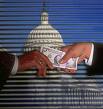“Deja Vu View” is our title to revive things we have written in the past that are worth revisiting given current events.
The federal government having to assume another $5 trillion in liabilities for Fannie Mae and Freddie Mac and $1 trillion in global losses on US mortgage market securities didn’t just happen. A big financial mess of this magnitude take years of complex engineering to create.
Unlike Alan Greenspan, many of the people who made this situation possible are not household names. To help you understand how this mess was engineered, here is that collection of evidence we posted in 2004 on another of our nominations for the top 20 people most responsible for the housing bubble.
We welcome your comments on who you would nominate to a top 20 list.



So if I build a hammer and you use it to hit someone over the head, it is my fault? Oh, my.
I would nominate Myron Scholes, Nobel Laureate and the father of all derivatives markets, whose pioneering Black-Scholes equation (upon which ALL 480 TRILLION of derivatives valuations are fundamentally related to) stated that stock prices followed a lognormal distribution, i.e. a Gaussian distribution, a bell curve.
This most fundamental of errors, combined with HYPERLEVERAGING has led to numerous sigma 5 events, none of which could be predicted by these models.
Which contradicts the original premise of a Gaussian distribution in the first place; stock prices and economic outcomes are SKEWED in their distributions with fat tails and greater kurtosis.
Without that asinine mistake of Scholes, the scope and magnitude of the coming HYPERDEFLATION would not have been possible.
Tony Buzan
James:
Your question is a good one but I don’t know how to answer it quickly. There are a number of different topics, including:
1. Manipulation and control of leaders
2. Control of media
3. Management of the currency and government depository functions
4. Management of government budget, debt and credit
5. Management of central bank and government data
6. Management of markets, including with use of the exchange stabilization fund
7. Enforcement, including military intervention
8. Secret societies and how they interact with government and the control and management of places
Grossly oversimplified, a boom requires a wide number of coordinated actions by federal government and central bank/banking entities. It is typically inflationary as it typically increases the money supply. However as it drives up asset values generally or in target areas, it often draws resources away from productive sectors. So it can be very deflationary to some sectors. This is one of the reasons why it is so liquidating of wealth.
Again, a wide variety of things can trigger a bust, shrinking the money supply, including reducing or pulling credit, increased enforcement, media spin promoting a drop in economic activity, market manipulation to drive prices down, and on and on.
If you have not read wwww.dunwalke.com, I would recommend. Also, read the posts here about naked short selling — this is one of many tools that has been documented. Naomi Klein’s book, the Shock Doctrine gives a good overview of some of the dump tools. The gata.org site has some good material on the manipulation of the gold markets. However, this is a wide topic and to my knowledge no one has yet written the “Joy of Cooking” for economic warfare. There is lots at the blog and in the archives if you want to keep reading back.
Catherine,
I’m trying to get all the fine details of the
central-banking-warfare-model, I feel I really need to understand these
things to get the whole picture.
Could you illuminate on this please . . .
I’ve learned from you that the ways in which criminal
economic fraud can work its way into the system are
disturbingly vast and complicated.
However, concerning booms and busts, can it be
simplified in terms of understanding the source?
Here’s what I’m getting at . .
Does not the federal reserve initiate any “boom” by flooding
the market with easy credit/money, in other words can all booms be generalized
as inflationary?
Also, what causes a “bust” to initiate?
Is it powerful players withdrawing or dumping stock
all at once or perhaps a domino effect?
Thanks for your help!
James